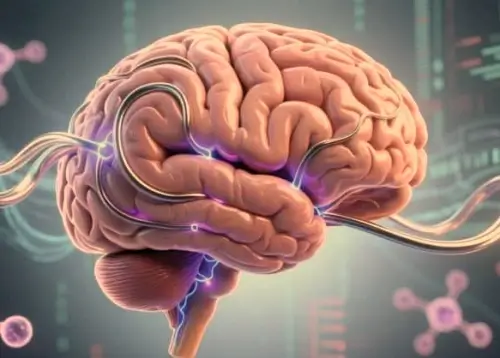Lithium. Alzheimer’s disease is one of the most devastating and complex illnesses of our time. It is a slow, relentless thief that robs individuals of their memories, their ability to think clearly, and their independence.
For decades, scientists and doctors have been in a desperate race against time to find a cure, but the path has been fraught with dead ends and setbacks.
Despite countless hours of research and billions of dollars in funding, a definitive cure remains elusive.
However, a groundbreaking discovery by researchers at Harvard Medical School has shed new light on an unexpected factor that may play a crucial role in the disease’s progression: the natural lithium present in our brains.
This finding challenges long-held assumptions and opens up a promising new avenue for prevention and treatment.
Lithium’s Natural Presence in the Brain
The Unexpected Discovery.
For years, lithium was primarily known in the medical community as a powerful psychiatric medication used to stabilize moods in individuals with bipolar disorder and severe depression.
Its presence in the brain was thought to be a direct result of this medication, not a natural occurrence. The prevailing belief was that the brain did not produce or store this element naturally.
This new research, however, turns that idea on its head.
The Harvard study, published in the prestigious journal Neuron, was born from a simple yet profound question: what chemical differences exist in the brains of people with and without Alzheimer’s?
To find the answer, researchers meticulously compared brain tissue samples from individuals who had died at various stages of cognitive health, from those with healthy brains to those who had suffered from severe Alzheimer’s.
They analyzed over 30 different metals and elements, expecting to find a host of variations. Yet, a single, striking difference stood out with remarkable consistency: the levels of lithium.
The brains of healthy individuals contained noticeably higher levels of lithium compared to those afflicted with Alzheimer’s.
This deficit was not confined to the late stages of the disease; a lack of lithium was even detected in individuals who had only experienced mild memory problems and had not yet progressed to full-blown dementia.
This finding suggests that a deficiency of natural lithium might be an early indicator—and perhaps even a contributing factor in the disease’s development.
Unraveling the Mechanism.
How Lithium Protects the Brain.
So, if natural lithium is a normal component of a healthy brain, what happens when its levels drop? To answer this, the researchers moved from human tissue analysis to animal models.
Their experiments on mice confirmed a direct link between lithium levels and the progression of Alzheimer’s.
When the mice’s natural lithium levels were reduced, there was a noticeable acceleration in the accumulation of two key pathological markers of Alzheimer’s: beta-amyloid plaques and tau tangles.
These rogue proteins are the hallmark of the disease.
Beta-amyloid plaques are sticky clumps that form between nerve cells, disrupting communication, while tau tangles are twisted fibers of protein that build up inside the neurons, leading to cell death.
The mice with lower lithium levels showed a more rapid buildup of these toxic proteins, which in turn led to more significant damage to their nerve cells and a more pronounced loss of memory.
The scientists propose a fascinating theory to explain this phenomenon: they believe that the very amyloid plaques that are so destructive to the brain may actually bind to and “trap” the natural lithium, effectively pulling it out of the nerve cells.
This creates a vicious cycle. The more amyloid plaques that form, the more lithium is sequestered, leading to a further decline in brain function and an acceleration of the disease. This theory not only explains the lithium deficit but also suggests a novel target for treatment.
A New Hope on the Horizon.
A Safer Approach to Lithium Therapy.
While lithium has been used clinically for years, the doses required for psychiatric treatment are high and come with a range of potentially serious side effects, including kidney problems, thyroid issues, and neurological complications.
A treatment for Alzheimer’s that relies on these high doses would likely be untenable. Recognizing this, the Harvard researchers set out to find a better way.
They successfully synthesized a new, custom-made lithium compound designed to avoid these problems. Unlike standard lithium, this new compound does not bind as readily to beta-amyloid, allowing it to remain in the cells and perform its protective functions at a much lower, safer dose.
The results of their experiments with this new compound were remarkable. When administered to mice with a model of Alzheimer’s, the compound effectively slowed down the brain damage and prevented memory loss, all without causing any of the toxic side effects associated with high-dose lithium.
This breakthrough paves the way for a potential new class of therapeutic drugs that could be used not just to treat, but perhaps even to prevent, the onset of Alzheimer’s.
Looking to the Future.
Clinical Trials and New Paradigms.
While these findings are incredibly exciting, it’s crucial to remember that they are based primarily on animal models. The next essential step is to conduct large-scale clinical trials on humans to confirm these results and ensure the safety and efficacy of the new compound.
If the human trials are successful, this research could fundamentally change how we approach the diagnosis and treatment of neurodegenerative diseases.
Imagine a future where a simple blood test for natural lithium levels could help predict an individual’s risk of developing dementia. Such a test could identify people who are susceptible to the disease long before they show any symptoms, allowing for early intervention.
This could take the form of dietary changes, supplements, or, if proven safe and effective, a low-dose prophylactic treatment with a compound like the one developed by the Harvard team.
The authors of the study are the first to admit that this is just the beginning. The role of natural lithium in the brain is a complex and largely uncharted territory.
There are still many questions to be answered: Where does the brain get its natural lithium? What other functions does it perform? How can we best maintain its optimal levels throughout a person’s life?
As science continues to uncover the secrets of this simple element, we may find that the key to protecting our most precious organ has been hidden in plain sight all along. The hope is that by understanding and leveraging the brain’s natural defenses, we can finally begin to turn the tide against Alzheimer’s and other devastating brain diseases.
Have a Great Day!




